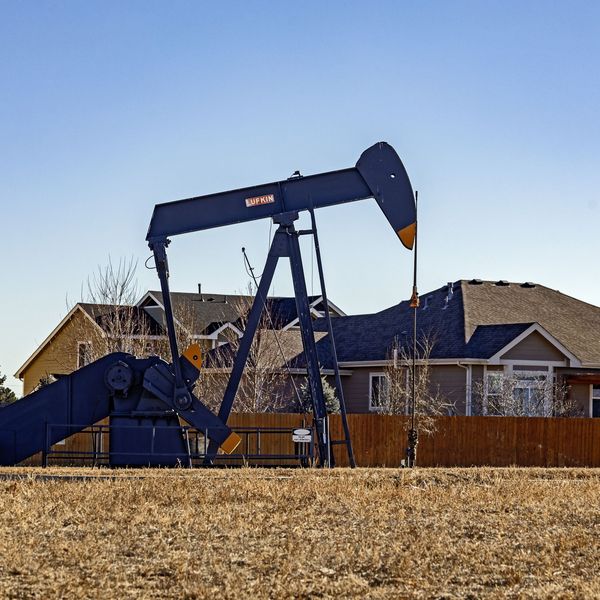
PFAS do not break down in the environment and bioaccumulate in the food chain. They are associated with birth defects and developmental damage to infants, the liver, kidneys and immune system, as well as cancer risk.
EPA Is Abandoning Those Suffering From Toxic PFAS Pollution
Even as the scientific case for regulating 'forever chemicals' grows clearer and more urgent every year, the EPA under President Trump delays and obfuscates.
A year ago, the Environmental Protection Agency (EPA) promised Congressional leaders that, after years of stalling, it would finally move forward on regulation of two notorious "forever chemicals," PFOA and PFOS. The notice that eventually appeared in the Federal Register on March 10, 2020, however, is not a regulation; it is merely a proposal to consider regulation. Worse, the timeline it sets out pushes actual regulation off for as long as five more years -- if it happens at all.
This marks the latest in a decades-long string of failures by EPA to protect Americans from these dangerous chemicals. Even as the scientific case for regulation grows clearer and more urgent every year, the EPA under President Trump delays and obfuscates.
PFOA and PFOS are the oldest of a class of synthetic per- and polyfluoroalkyl chemicals known collectively as PFAS. Over 5,000 variations of PFAS are currently used in the manufacture of consumer goods including cookware, flame-retardants, waterproofing, furniture and take-out containers.
The Environmental Working Group estimates up to 110 million people could be drinking water with PFAS in it.
Nonetheless, the EPA has dragged its feet on regulating PFAS. Industry voluntarily began phasing out the original "long-chain" PFAS, starting with PFOS in 2002 and PFOA by 2015. It set a non-binding "lifetime health advisory" for drinking water contaminated with PFOA and PFOS in 2016, near the end of the Obama administration.
Meanwhile, the more numerous and less-studied "short-chain" PFAS continue to proliferate. Indeed, the EPA has approved new versions without testing their safety and never finalized key toxicity studies.
On Feb. 14, 2019, the EPA issued a PFAS Action Plan that promised the establishment of a maximum contaminant level (MCL) for PFOA and PFOS in drinking water. The EPA promised it would propose a regulatory determination under the Safe Drinking Water Act by the end of that year and said it was "also gathering and evaluating information to determine if a SDWA [Safe Drinking Water Act] regulation is appropriate for a broader class of PFAS."
The Federal Register notice that appeared more than a year later, however, shows EPA is actually proposing only to consider developing regulations for PFOA and PFOS, and merely continuing to gather information on other PFAS chemicals.
The nearly five-year regulatory timeline it describes makes it abundantly clear that EPA has no intention of protecting Americans from PFAS contamination as long as President Trump is in office.
Trump's EPA has taken only one definite action on PFAS, proposing to restrict imported products containing PFOA and PFOS. However, Sen. Tom Carper (D-Del.) recently released documents that show the White House has worked to create glaring loopholes in this proposal so that many products containing PFOA and PFOS could enter the U.S.
Several bills introduced in Congress have tried to force the EPA to do its job, only to earn a veto threat from President Trump.
Finally this year, the National Defense Authorization Act for Fiscal Year 2020 added 172 PFAS chemicals to the Toxic Release Inventory, which requires reporting by facilities that manufacture or process chemicals included on the list.
But reporting is not enough. The Environmental Working Group estimates that at least 2,500 industrial facilities across the U.S. could be discharging PFAS into the air and water.
Some states have begun filling the regulatory void, but many PFAS-contaminated sites are the result of Department of Defense (DoD) pollution and DoD is refusing to comply with state clean-up laws and standards. For example, at Cannon Air Force Base in New Mexico, the State was forced to sue DoD, but the Air Force continues to ignore the state environmental laws.
While the number of sites with PFAS contamination continues to grow, Trump's EPA continues to do nothing to address this toxic mess.
An Urgent Message From Our Co-Founder
Dear Common Dreams reader, The U.S. is on a fast track to authoritarianism like nothing I've ever seen. Meanwhile, corporate news outlets are utterly capitulating to Trump, twisting their coverage to avoid drawing his ire while lining up to stuff cash in his pockets. That's why I believe that Common Dreams is doing the best and most consequential reporting that we've ever done. Our small but mighty team is a progressive reporting powerhouse, covering the news every day that the corporate media never will. Our mission has always been simple: To inform. To inspire. And to ignite change for the common good. Now here's the key piece that I want all our readers to understand: None of this would be possible without your financial support. That's not just some fundraising cliche. It's the absolute and literal truth. We don't accept corporate advertising and never will. We don't have a paywall because we don't think people should be blocked from critical news based on their ability to pay. Everything we do is funded by the donations of readers like you. Will you donate now to help power the nonprofit, independent reporting of Common Dreams? Thank you for being a vital member of our community. Together, we can keep independent journalism alive when it’s needed most. - Craig Brown, Co-founder |
A year ago, the Environmental Protection Agency (EPA) promised Congressional leaders that, after years of stalling, it would finally move forward on regulation of two notorious "forever chemicals," PFOA and PFOS. The notice that eventually appeared in the Federal Register on March 10, 2020, however, is not a regulation; it is merely a proposal to consider regulation. Worse, the timeline it sets out pushes actual regulation off for as long as five more years -- if it happens at all.
This marks the latest in a decades-long string of failures by EPA to protect Americans from these dangerous chemicals. Even as the scientific case for regulation grows clearer and more urgent every year, the EPA under President Trump delays and obfuscates.
PFOA and PFOS are the oldest of a class of synthetic per- and polyfluoroalkyl chemicals known collectively as PFAS. Over 5,000 variations of PFAS are currently used in the manufacture of consumer goods including cookware, flame-retardants, waterproofing, furniture and take-out containers.
The Environmental Working Group estimates up to 110 million people could be drinking water with PFAS in it.
Nonetheless, the EPA has dragged its feet on regulating PFAS. Industry voluntarily began phasing out the original "long-chain" PFAS, starting with PFOS in 2002 and PFOA by 2015. It set a non-binding "lifetime health advisory" for drinking water contaminated with PFOA and PFOS in 2016, near the end of the Obama administration.
Meanwhile, the more numerous and less-studied "short-chain" PFAS continue to proliferate. Indeed, the EPA has approved new versions without testing their safety and never finalized key toxicity studies.
On Feb. 14, 2019, the EPA issued a PFAS Action Plan that promised the establishment of a maximum contaminant level (MCL) for PFOA and PFOS in drinking water. The EPA promised it would propose a regulatory determination under the Safe Drinking Water Act by the end of that year and said it was "also gathering and evaluating information to determine if a SDWA [Safe Drinking Water Act] regulation is appropriate for a broader class of PFAS."
The Federal Register notice that appeared more than a year later, however, shows EPA is actually proposing only to consider developing regulations for PFOA and PFOS, and merely continuing to gather information on other PFAS chemicals.
The nearly five-year regulatory timeline it describes makes it abundantly clear that EPA has no intention of protecting Americans from PFAS contamination as long as President Trump is in office.
Trump's EPA has taken only one definite action on PFAS, proposing to restrict imported products containing PFOA and PFOS. However, Sen. Tom Carper (D-Del.) recently released documents that show the White House has worked to create glaring loopholes in this proposal so that many products containing PFOA and PFOS could enter the U.S.
Several bills introduced in Congress have tried to force the EPA to do its job, only to earn a veto threat from President Trump.
Finally this year, the National Defense Authorization Act for Fiscal Year 2020 added 172 PFAS chemicals to the Toxic Release Inventory, which requires reporting by facilities that manufacture or process chemicals included on the list.
But reporting is not enough. The Environmental Working Group estimates that at least 2,500 industrial facilities across the U.S. could be discharging PFAS into the air and water.
Some states have begun filling the regulatory void, but many PFAS-contaminated sites are the result of Department of Defense (DoD) pollution and DoD is refusing to comply with state clean-up laws and standards. For example, at Cannon Air Force Base in New Mexico, the State was forced to sue DoD, but the Air Force continues to ignore the state environmental laws.
While the number of sites with PFAS contamination continues to grow, Trump's EPA continues to do nothing to address this toxic mess.
A year ago, the Environmental Protection Agency (EPA) promised Congressional leaders that, after years of stalling, it would finally move forward on regulation of two notorious "forever chemicals," PFOA and PFOS. The notice that eventually appeared in the Federal Register on March 10, 2020, however, is not a regulation; it is merely a proposal to consider regulation. Worse, the timeline it sets out pushes actual regulation off for as long as five more years -- if it happens at all.
This marks the latest in a decades-long string of failures by EPA to protect Americans from these dangerous chemicals. Even as the scientific case for regulation grows clearer and more urgent every year, the EPA under President Trump delays and obfuscates.
PFOA and PFOS are the oldest of a class of synthetic per- and polyfluoroalkyl chemicals known collectively as PFAS. Over 5,000 variations of PFAS are currently used in the manufacture of consumer goods including cookware, flame-retardants, waterproofing, furniture and take-out containers.
The Environmental Working Group estimates up to 110 million people could be drinking water with PFAS in it.
Nonetheless, the EPA has dragged its feet on regulating PFAS. Industry voluntarily began phasing out the original "long-chain" PFAS, starting with PFOS in 2002 and PFOA by 2015. It set a non-binding "lifetime health advisory" for drinking water contaminated with PFOA and PFOS in 2016, near the end of the Obama administration.
Meanwhile, the more numerous and less-studied "short-chain" PFAS continue to proliferate. Indeed, the EPA has approved new versions without testing their safety and never finalized key toxicity studies.
On Feb. 14, 2019, the EPA issued a PFAS Action Plan that promised the establishment of a maximum contaminant level (MCL) for PFOA and PFOS in drinking water. The EPA promised it would propose a regulatory determination under the Safe Drinking Water Act by the end of that year and said it was "also gathering and evaluating information to determine if a SDWA [Safe Drinking Water Act] regulation is appropriate for a broader class of PFAS."
The Federal Register notice that appeared more than a year later, however, shows EPA is actually proposing only to consider developing regulations for PFOA and PFOS, and merely continuing to gather information on other PFAS chemicals.
The nearly five-year regulatory timeline it describes makes it abundantly clear that EPA has no intention of protecting Americans from PFAS contamination as long as President Trump is in office.
Trump's EPA has taken only one definite action on PFAS, proposing to restrict imported products containing PFOA and PFOS. However, Sen. Tom Carper (D-Del.) recently released documents that show the White House has worked to create glaring loopholes in this proposal so that many products containing PFOA and PFOS could enter the U.S.
Several bills introduced in Congress have tried to force the EPA to do its job, only to earn a veto threat from President Trump.
Finally this year, the National Defense Authorization Act for Fiscal Year 2020 added 172 PFAS chemicals to the Toxic Release Inventory, which requires reporting by facilities that manufacture or process chemicals included on the list.
But reporting is not enough. The Environmental Working Group estimates that at least 2,500 industrial facilities across the U.S. could be discharging PFAS into the air and water.
Some states have begun filling the regulatory void, but many PFAS-contaminated sites are the result of Department of Defense (DoD) pollution and DoD is refusing to comply with state clean-up laws and standards. For example, at Cannon Air Force Base in New Mexico, the State was forced to sue DoD, but the Air Force continues to ignore the state environmental laws.
While the number of sites with PFAS contamination continues to grow, Trump's EPA continues to do nothing to address this toxic mess.

